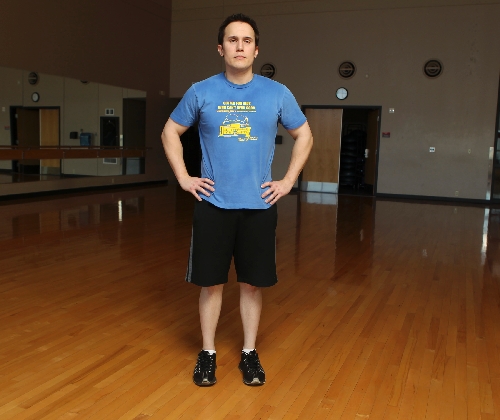Hanging in the balance: Try these steps for better stability

When was the last time you played hopscotch? Do you dare try it today?
Think about it. Hopping on one foot without touching the sidewalk with the other. Then bending down, on that one foot, to pick up a rock or taw. It was fun once. But if a child’s game sounds like an injury waiting to happen today, then you might need to work on your balance.
Reasons for toppling can be as simple as inactivity or as complicated as the inner ear. Our bodies have a default setting to choose the path of least resistance to help us conserve energy. If you are not used to moving and stabilizing in odd ways, then your body will not contribute energy to balance. Frankly, it will let you down. If you walk only to the car, and the refrigerator, and the couch, then all you’re good for is walking and your balance will be lost over time.
Injury and tight muscles also can affect balance. When the body is injured, the time it takes to heal can decondition your muscles. Those weak muscles will cause other muscles to recruit in their place and create a tight muscle somewhere else. This muscle imbalance could make you unstable.
Vertigo is not a new liqueur but it can affect your balance in similar ways. If you have problems with your body’s sensory systems, you’ll likely experience balance issues. Your vision, certain nerves and your inner ear all contribute to sensory input relating to balance. Training can help improve your balance with time, even if you have vertigo. Of course, it’s best if you’re sober.
Honing your balance skills has many benefits. It can help decrease injury and improve sports performance. When you train balance, you put your body into an unstable position. As you learn to stabilize yourself in that position, you strengthen tendons and ligaments around the joints. This has a conditioning effect and has been shown to help reduce injury among all age groups.
Balance training shouldn’t be an isolated exercise. Since your body is constantly balancing during the day, training should be at least as diverse as your daily movements. Being able to stand on one leg will have little functional effect if you have groceries in one arm, a kid in the other and just happen to drop your keys before you get to the door.
Try variations in different planes of movement — forward, sideway and diagonally. Progress the standing-on-one-leg exercise to pivoting up and down on your tiptoes. Hop from one foot to the other, letting yourself stabilize. Try bending the knee to different degrees while on one foot.
Create a controlled and unstable environment when practicing your balance. Having something be "controlled" and "unstable" sounds like a contradiction, but both elements are necessary. There should be no fear of getting hurt because you will start small and progress to higher levels when you have mastered the basics.
Control the environment by having a bar, trainer or workout buddy close should you become wobbly.
Start with a stable environment and gradually make it unstable. If you can stand on one foot then try standing on a foam pad. Then try a Dyna Disc (an inflatable cushion used for balance training). Then advance to a half Bosu ball.
It is normal for people to have one side that’s more stable than the other. Notice how the different calf muscles fire to contract and release as you balance. That’s the body learning.
Maintaining proper form is important as you do balance exercises. If you continue with, or teach your body an incorrect form, then you can make an existing muscle’s imbalance even worse. Basic form is to have the feet shoulder-width apart and toes pointed straight ahead. Keep the ankles, knees, hips and shoulders in line. Straighten the back and maintain core activation. Keep an eye on your ankles. If the arch flattens, the ankle is in an unsafe position.
Chris Huth is a Las Vegas trainer. You can contact him at 702trainer@gmail.com. Before beginning any exercise program, consult your physician.